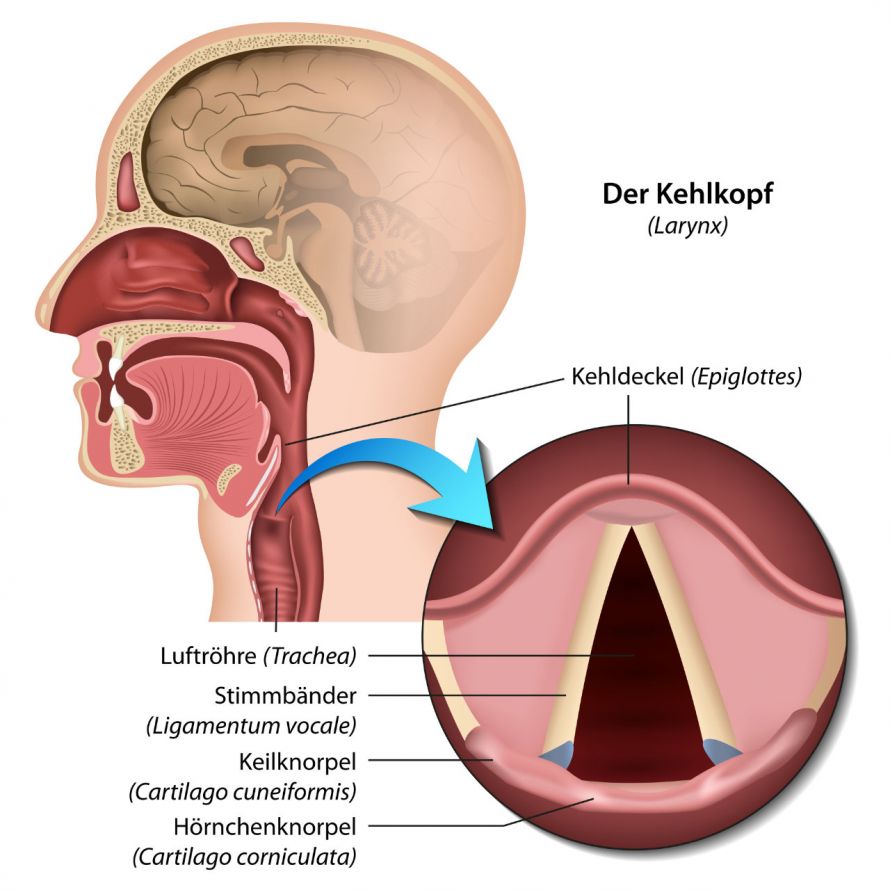The larynx is located in the throat and connects the pharynx with the oesophagus and the windpipe. It enables you to speak and breathe.
Malignant laryngeal tumour occurs in three forms:
- Glottic laryngeal carcinoma: Affects the vocal cords (glottis) and is the most common cancer of the larynx.
- Supraglottic laryngeal cancer: Grows above the vocal folds.
- Subglottic laryngeal carcinoma: Grows below the vocal folds.
In advanced stages, laryngeal carcinoma forms metastases. They first appear in the neighbouring lymph nodes and later in more distant regions of the body.
5 years after the diagnosis of laryngeal cancer, statistically 6 out of 10 affected persons are still alive (five-year prognosis).

The position and anatomy of the larynx © bilderzwerg | AdobeStock
Smoking is considered the main risk factor for the development of the malignant tumour. In addition, excessive consumption of alcohol contributes to the development of laryngeal carcinoma. Smoking and alcohol have a direct influence on the formation of the pathologically changed cells.
In addition, infection with human papilloma viruses (HPV) can promote the occurrence of laryngeal tumours.
Toxic chemical substances such as
- Chrome,
- Arsenic,
- Asbestos,
- Nickel and
- polycyclic aromatic hydrocarbons (PAHs)
increase the risk of developing laryngeal cancer later on. Some occupational groups come into contact with these toxic substances. In older houses, asbestos cement panels may also be installed, increasing the risk of cancer for residents.
Furthermore, laryngeal cancer can be genetically determined.
The symptoms of laryngeal cancer depend on the section of the larynx where the tumour forms.
In the early stages of vocal cord carcinoma, sufferers are often hoarse and have to clear their throat. Therefore, this form of cancer can be diagnosed well at an early stage.
Other signs of laryngeal cancer are constant scratching in the throat and a chronic cough. In the subsequent period, there are also clearly audible breathing sounds and shortness of breath.
Supraglottic tumours can usually only be detected at a late stage. The sufferers
- often have swollen neck lymph nodes
- have difficulty swallowing
- have a foreign body sensation ("lump") in the throat
Laryngeal tumours located below the glottis (glottis) make themselves known in the form of
- Hoarseness,
- Irritation in the throat and
- later breathing difficulties.
Hoarseness lasting longer than 3 weeks without a recognisable other cause (sore throat) can indicate laryngeal cancer. If you have these symptoms, please contact an ear, nose and throat specialistas soon as possible.
Advanced laryngeal cancer presents with less specific signs such as
- bloody sputum
- strong bad breath
- weight loss
If a laryngeal tumour is suspected, the doctor first performs a laryngoscopy. This is usually done with the help of a flexible endoscope and 90° angle optics. The patient is under general anaesthesia. During the laryngoscopy, the doctor takes a tissue sample and sends it to the laboratory for examination. There, it is examined for cancer cells.
Palpation of the neck or ultrasound examination may also reveal swollen lymph nodes.
A microlaryngoscopy provides the doctor with further information. The doctor can see, for example, whether the tumour is growing inwards, outwards or under the mucous membrane and whether the vocal cords are still mobile.
Imaging technologies such as
- Ultrasound,
- Computed tomography (CT) and
- Magnetic resonance imaging (MRI)
show the exact location and extent of the tumour.
In addition, the ENT specialist must clarify whether there is another malignant tumour, for example in the oesophagus or the lungs. To do this, he performs an oesophageal and a bronchial endoscopy (bronchoscopy).
An X-ray image of the lung shows the size and location of the secondary tumour.
Laryngeal cancer treatment depends on
- where the lump is located,
- how big it is and
- which stage of cancer was diagnosed.
The patient's health condition and age also play a role in the decision.
On the basis of these conditions, the specialist advises a surgical intervention and/or radiation treatment or chemotherapy. Sometimes the latter are also used together.
Surgery for early stage laryngeal cancer
Laryngeal cancer in the early stage has a favourable prognosis because it can often be completely removed by surgery.
If it is in a place that is easily accessible through the mouth, the tumour can be cut out endoscopically and microscopically using a laser. This minimally invasive procedure leaves only a small incision and spares healthy tissue.
If this is not possible, the larynx is opened with a scalpel.
After the operation, patients usually have breathing difficulties. In order to ensure that the patient gets enough air, an artificial breathing opening (tracheostoma) is usually temporarily placed at the front of the neck.
Surgery for advanced stages of laryngeal cancer
Laryngeal tumours in advanced stages are more difficult to operate on. They can only be treated by a complete removal of the larynx (laryngectomy). If the neck lymph nodes are already affected, they must also be removed.
Patients need a tracheostoma after surgery and speak through an artificial speaking valve.
Tumour cells may still be present in the body after surgery. In order to kill these, radiation treatment is used in advanced stages of the tumour radiotherapy and/or medication (conservative treatment).
If the risk of surgery would be too great for the patient, the only treatment option left is conservative therapy. This is also the case in the earlier tumour stage.
In the 5 years following the operation, the patient should undergo regular check-ups.















